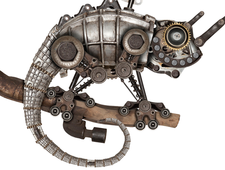Getting Started
Open Hardware – Arduino

© Lead Image © Burmakin Andrey, 123RF.com
Whether you are building your own device or customizing one, Arduino technology often functions as the foundation for your open hardware project. Here's how to get started with Arduino products.
Arduino single-board microcontrollers [1] were originally intended for educational and do-it-yourself projects. Increasingly, though, they are a foundation for Internet of Things (IoT) projects and open hardware. Sometimes, they are used only for prototyping, but, just as often today, they are found in commercial products ranging from keyboards to prosthetics. If you are involved in open hardware, knowing how to work with Arduino products is quickly becoming essential.
Arduino boards are influential for several reasons. To start, while limited in scope, Arduino boards are powerful enough for many dedicated purposes. If they are not, chaining them or using extension hardware known as shields can easily extend their usability. Just as importantly, Arduino boards can interact with Linux, OS X, or Windows, as well as other single-board microcontrollers like the Raspberry Pi.
Moreover, Arduino offers widespread support for all user levels. This support includes its own IDE and a programming language that is a variant of C, a Creative Commons license, and a community of thousands. With this support, users can begin to work without experience in electronics or programming. At the same time, Arduino is flexible enough to meet the needs of experts as well.
[...]
Buy this article as PDF
(incl. VAT)
Buy Linux Magazine
Subscribe to our Linux Newsletters
Find Linux and Open Source Jobs
Subscribe to our ADMIN Newsletters
Support Our Work
Linux Magazine content is made possible with support from readers like you. Please consider contributing when you’ve found an article to be beneficial.

News
-
Another Linux Malware Discovered
Russian hackers use Hyper-V to hide malware within Linux virtual machines.
-
TUXEDO Computers Announces a New InfinityBook
TUXEDO Computers is at it again with a new InfinityBook that will meet your professional and gaming needs.
-
SUSE Dives into the Agentic AI Pool
SUSE becomes the first open source company to adopt agentic AI with SUSE Enterprise Linux 16.
-
Linux Now Runs Most Windows Games
The latest data shows that nearly 90 percent of Windows games can be played on Linux.
-
Fedora 43 Has Finally Landed
The Fedora Linux developers have announced their latest release, Fedora 43.
-
KDE Unleashes Plasma 6.5
The Plasma 6.5 desktop environment is now available with new features, improvements, and the usual bug fixes.
-
Xubuntu Site Possibly Hacked
It appears that the Xubuntu site was hacked and briefly served up a malicious ZIP file from its download page.
-
LMDE 7 Now Available
Linux Mint Debian Edition, version 7, has been officially released and is based on upstream Debian.
-
Linux Kernel 6.16 Reaches EOL
Linux kernel 6.16 has reached its end of life, which means you'll need to upgrade to the next stable release, Linux kernel 6.17.
-
Amazon Ditches Android for a Linux-Based OS
Amazon has migrated from Android to the Linux-based Vega OS for its Fire TV.

